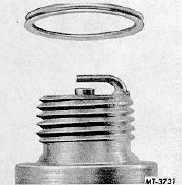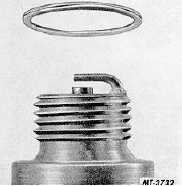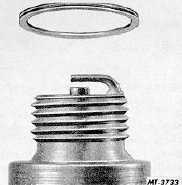|
| |
TRUCK SERVICE MANUAL
TM 5-4210-230-14&P-1
ELECTRICAL
REMOVAL
When removing the spark plugs from the engine,
certain items should be remembered:
1.
When disconnecting ignition cables from spark plugs,
do not pull on cables but grasp the cable boot and
carefully pull. To pull on cable may break the
conductor in the resistor-type cable.
2.
Observe location and routing of cables to avoid
incorrect installation. Special attention should be given
in routing spark plug cables, as cross fire (carburetor
spit-back), rough operating engine, or short plug life
will result if incorrect wire routing is encountered. If an
engine is suspected of incorrect wire routing, compare
wires with an engine which is known to be correct.
NOTE:
Cross fire is most likely to occur on a V8
engine between consecutively firing cylinders
when these cylinders are located on the same
bank.
3.
After loosening each plug about two turns, blow out any
accumulation of dirt around the base of plugs with
compressed air. This prevents debris falling into
cylinder
combustion
chambers
when
plugs
are
removed.
INSPECTION
Discussed in the following paragraphs are various instructions
pertaining to different spark plug appearances and possible
causes of their defects.
Preliminary Examination
If spark plugs in question reveal cracks, worn
electrodes or other obviously unsatisfactory conditions, they
should not be used again.
Gaskets
If the spark plug gaskets are not compressed, Fig. 1, it
is an indication that the plugs have not been properly
tightened to prevent blow-by between the spark plug and
cylinder head. This condition results in excessive burning of
the electrodes and overheats the insulator tip, which may
cause preignition.
If the gaskets are flattened or compressed to a point
where they have become distorted (out of round) or torn, Fig.
2, it is an indication that the spark plugs have been tightened
to the extent that damage may have been inflicted on the plug
itself.
Excessive torque will cause strain on the steel shell of
the spark plug and result in cracked insulators, distortion of
metal shell
and gap setting, as well as blow-by between the
component parts of the plug.
If the gasket is properly compressed (approximately
one-half of the original thickness) showing a flat, clean, even
surface, Fig. 3, it indicates that the spark plugs were properly
installed.
Spark Plug Appearances
Deposits normally occur in distinct bands on insulator.
The tip deposits near the electrodes are the ones which may
affect spark operation. If they become conductive, their
"shunt resistance" is said to drop, and the plug is short
circuited.
Fig. 1 Not Properly Tightened (Gasket Not
Compressed)
Fig. 2 Overtightened (Gasket Distorted)
Fig. 3 Properly Torqued
CTS-2016-J Page 3
PRINTED IN UNITED STATES OF A MERICA
|



